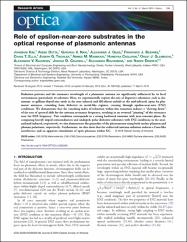| dc.contributor.author | Kim, Jongbum | |
| dc.contributor.author | Dutta, Aveek | |
| dc.contributor.author | Naik, Gururaj V. | |
| dc.contributor.author | Giles, Alexander J. | |
| dc.contributor.author | Bezares, Francisco J. | |
| dc.contributor.author | Ellis, Chase T. | |
| dc.contributor.author | Tischler, Joseph G. | |
| dc.contributor.author | Mahmoud, Ahmed M. | |
| dc.contributor.author | Caglayan, Humeyra | |
| dc.contributor.author | Glembocki, Orest J. | |
| dc.contributor.author | Kildishev, Alexander V. | |
| dc.contributor.author | Caldwell, Joshua D. | |
| dc.contributor.author | Boltasseva, Alexandra | |
| dc.contributor.author | Engheta, Nader | |
| dc.date.accessioned | 2020-02-05T11:17:28Z | |
| dc.date.available | 2020-02-05T11:17:28Z | |
| dc.date.issued | 2016 | en_US |
| dc.identifier.issn | 2334-2536 | |
| dc.identifier.other | 10.1364/OPTICA.3.000339 | |
| dc.identifier.uri | https://hdl.handle.net/20.500.12573/136 | |
| dc.description | Office of Naval Research (ONR) (N00014-10-1-0942); Air Force Office of Scientific Research (AFOSR) (FA9550-14-1-0389); NRC/ASEE Postdoctoral Fellowship Naval Research Laboratory Nanoscience Institute (from ONR). | en_US |
| dc.description.abstract | Radiation patterns and the resonance wavelength of a plasmonic antenna are significantly influenced by its local environment, particularly its substrate. Here, we experimentally explore the role of dispersive substrates, such as aluminum-or gallium-doped zinc oxide in the near infrared and 4H-silicon carbide in the mid-infrared, upon Au plasmonic antennas, extending from dielectric to metal-like regimes, crossing through epsilon-near-zero (ENZ) conditions. We demonstrate that the vanishing index of refraction within this transition induces a "slowing down" of the rate of spectral shift for the antenna resonance frequency, resulting in an eventual "pinning" of the resonance near the ENZ frequency. This condition corresponds to a strong backward emission with near-constant phase. By comparing heavily doped semiconductors and undoped, polar dielectric substrates with ENZ conditions in the near- and mid-infrared, respectively, we also demonstrate the generality of the phenomenon using both surface plasmon and phonon polaritons, respectively. Furthermore, we also show that the redirected antenna radiation induces a Fano-like interference and an apparent stimulation of optic phonons within SiC. (C) 2016 Optical Society of America | en_US |
| dc.description.sponsorship | Office of Naval Research N00014-10-1-0942 United States Department of Defense Air Force Office of Scientific Research (AFOSR) FA9550-14-1-0389 NRC/ASEE Postdoctoral Fellowship Naval Research Laboratory Nanoscience Institute (ONR) | en_US |
| dc.language.iso | eng | en_US |
| dc.publisher | OPTICAL SOC AMER, 2010 MASSACHUSETTS AVE NW, WASHINGTON, DC 20036 USA | en_US |
| dc.relation.ispartofseries | Volume: 3; | |
| dc.relation.ispartofseries | Issue: 3; | |
| dc.relation.ispartofseries | Pages: 339-346; | |
| dc.rights | info:eu-repo/semantics/openAccess | en_US |
| dc.subject | SURFACE PHONON POLARITONS | en_US |
| dc.subject | NANOANTENNA ARRAYS | en_US |
| dc.subject | GRAPHENE PLASMONS | en_US |
| dc.subject | BORON-NITRIDE | en_US |
| dc.subject | METAMATERIALS | en_US |
| dc.subject | LIGHT | en_US |
| dc.subject | ABSORPTION | en_US |
| dc.subject | INDEX | en_US |
| dc.subject | REALIZATION | en_US |
| dc.subject | WAVELENGTHS | en_US |
| dc.title | Role of epsilon-near-zero substrates in the optical response of plasmonic antennas | en_US |
| dc.type | article | en_US |
| dc.contributor.department | AGÜ, Mühendislik Fakültesi, Elektrik & Elektronik Mühendisliği Bölümü | en_US |
| dc.contributor.institutionauthor | | |
| dc.identifier.doi | 10.1364/OPTICA.3.000339 | |
| dc.relation.publicationcategory | Makale - Uluslararası Hakemli Dergi - Kurum Öğretim Elemanı | en_US |


















